| Back Number | No.13 2005/04/13 | |||
| News | EXPO 2005 Message Events, Opening Forum “Living on the EARTH” held |  |
||
| Pavilions : Nordic Pavilion, “Oasis in the North” | ||||
| Interview | Phillip Gibson (New Zealand) New Zealand Commissioner General of EXPO 2005 Aichi, Japan |
|||
| Column | In the Evening at Koi-Pond | |||
 |
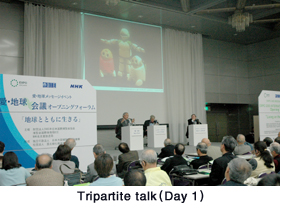 The EXPO 2005 International Forums, a collection of relayed symposia on the same theme, began on March 27 and 28 with global intellectuals in attendance. These events are the first of its kind in World Exposition history. The shared theme of the forums is “Creation of Sustainable Society.”
The EXPO 2005 International Forums, a collection of relayed symposia on the same theme, began on March 27 and 28 with global intellectuals in attendance. These events are the first of its kind in World Exposition history. The shared theme of the forums is “Creation of Sustainable Society.”The EXPO 2005 International Forums will be held every month as part of EXPO 2005 Message Events. The results of the forums will be transmitted to the world in September this year as a message from EXPO 2005 Aichi, Japan. The event will also include monthly EXPO 2005 International Workshops, which will consist of concerts, workshops and other events. The general producer of these events is Shosaburo Kimura (General Producer of 2005 World Exposition and Professor Emeritus, the University of Tokyo). The recently held EXPO 2005 International Forums was entitled “Opening Forum: Living on the EARTH.” Day 1 of the two-day Opening Forum was held in Nagoya City. After a keynote speech, a tripartite talk was given on the theme “Mutual relationship among culture, environment and development; and the possibility of balanced development.” |
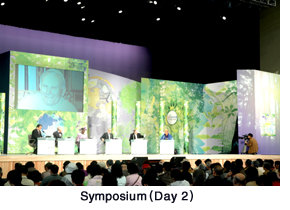 On the following day, a symposium, in keeping with the content of Day 1, was held at EXPO Dome in the Nagakute Area of the, EXPO venue. The theme was “Issues to be resolved in creating a sustainable society.”
On the following day, a symposium, in keeping with the content of Day 1, was held at EXPO Dome in the Nagakute Area of the, EXPO venue. The theme was “Issues to be resolved in creating a sustainable society.”Lester R. Brown, President, Earth Policy Institute (U.S.A.); and Donald J. Johnston, Secretary-General of the OECD, who had both participated in Day 1, took part in this symposium as panelists together with Wangari Maathai, Assistant Minister for Environment of Kenya and winner of last year’s Nobel Peace Prize; Gro Harlem Brundtland, former Prime Minister of Norway (and former Director-General of the WHO); and Kazumoto Yamamoto of Japan, Co-chairman of Committee on Environment and Safety of Nippon Keidanren. Words of blessings for the opening of EXPO 2005 Aichi, Japan from His Holiness the late Pope John Paul II was read out loud at the beginning of the symposium. In this message, the Pope said, “Upon all those taking part in this noteworthy Exposition I invoke the driven gifts of peace and harmony.” |
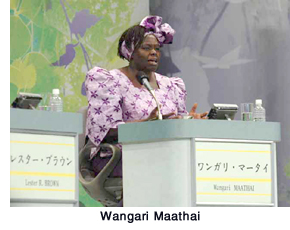 The symposium then began, and there was an enthusiastic exchange of opinions. Wangari Maathai said the Japanese word “mottainai” is a beautiful word because it symbolizes the spirit of valuing things without putting our limited resources to waste, and also expresses appreciation towards nature which gives us a multitude of things. She said that she wanted to make this word an important concept of environmental protection activities, which struck a chord with the audience.
The symposium then began, and there was an enthusiastic exchange of opinions. Wangari Maathai said the Japanese word “mottainai” is a beautiful word because it symbolizes the spirit of valuing things without putting our limited resources to waste, and also expresses appreciation towards nature which gives us a multitude of things. She said that she wanted to make this word an important concept of environmental protection activities, which struck a chord with the audience.There was also interesting discussion about the various environmental conservation technologies in actual use at the EXPO 2005 venue, including the supply of electricity at Japan Pavilion Nagakute, in its entirety, using the New Energy System. A visual report on biodiversity by an explorer of the ocean and several other reports were shown on a screen between the discussions. The content of the panel discussion was deepened further on the basis of these reports. Videotaped messages from world-renowned intellectuals were also shown on screen and had a deep impact on the audience. It included a message from former President of the Soviet Union Mikhail Gorbachev, now President, Green Cross International (an NGO involved in ecology issues), who called upon the youths of the world gathering at EXPO 2005 to protect the environment. |
![]()
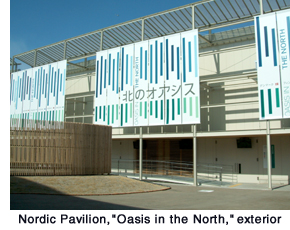 On the most southern part of the Global Loop in the Nagakute Area is Global Common 4, home to the pavilions of 21 uniquely distinct European countries including those of Northern and Eastern Europe. The Nordic Pavilion, “Oasis in the North,” is located in a corner of this Global Common. This is the joint pavilion of the five Nordic countries - Denmark, Finland, Iceland, Norway and Sweden - which have close cooperative relationships and share many aspects, such as the natural environment, history and language.
On the most southern part of the Global Loop in the Nagakute Area is Global Common 4, home to the pavilions of 21 uniquely distinct European countries including those of Northern and Eastern Europe. The Nordic Pavilion, “Oasis in the North,” is located in a corner of this Global Common. This is the joint pavilion of the five Nordic countries - Denmark, Finland, Iceland, Norway and Sweden - which have close cooperative relationships and share many aspects, such as the natural environment, history and language.Upon entering the Nordic Pavilion, visitors will be greeted by the scent of wood and the start of a loop that traverses the pavilion. The “Nordic Loop” underfoot is made of a type of Finnish cedar. The footage shown on five screens placed on the wall near the entrance provides a comprehensive introduction to each of the five Nordic countries, including their geographical features and industries. As visitors proceed along the loop, they suddenly find themselves in a large zone with 9-meter-high white paper screens. The walls reflect the soft light of the room and create a mystical world of Northern Europe. At the foot of the wall is a “lake” where visitors launch small paper boats. Messages to the people of the Nordic region are entered in computers that are set up around the lake, printed out, folded into paper boats and launched. A screen on the other side of the lake shows people of the Nordic region finding these boats. The messages entered into the computers will be delivered to the people of the five Nordic countries upon the conclusion of EXPO 2005 Aichi, Japan. It is an enjoyable and interactive zone that befits the Nordic region that is known for its advanced IT technology. |
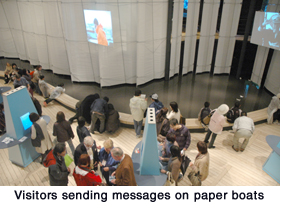 Further on, visitors are greeted by a Nordic forest that has been recreated using trees, soil and moss brought over from Finland. The scent of the trees soothe the hearts of visitors.
Further on, visitors are greeted by a Nordic forest that has been recreated using trees, soil and moss brought over from Finland. The scent of the trees soothe the hearts of visitors.Footage of a waterfall then appears on the other side of the loop. This is where cutting-edge technology for sustainable energy - from water and wind to geothermal power - is introduced. It shows the wisdom of the Nordic region, which has been advancing environment-friendly energy policies ahead of the world, for living in harmony with nature. Next, visitors will be introduced to the Nordic way of life through mini-documentaries, photographs and exhibits of clothing, tools and other displays. See the daily lives of the people of the Nordic region, including a young man enjoying cross-country skiing and a happy little girl at her birthday party. The relaxed manner in which the people of the region enjoy their lifestyles gives a good example of how humankind can live in coexistence with nature. |
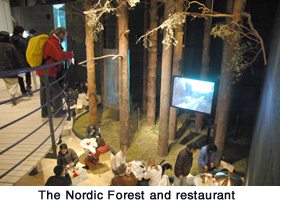 The “20 Stories of Nordic Design” is a zone introducing the practical, simple yet sophisticated designs of Scandinavia, from glass products, such as lamps, to cars. A number of the Nordic design products can be purchased at the pavilion shop.
The “20 Stories of Nordic Design” is a zone introducing the practical, simple yet sophisticated designs of Scandinavia, from glass products, such as lamps, to cars. A number of the Nordic design products can be purchased at the pavilion shop.Finally, amidst the scent of trees and the sound of babbling streams, visitors will be able to take delight in a wide array of Nordic cuisine, including fish dishes. The Nordic Pavilion is one through which visitors can relish the beauty of the Nordic region, and experience through their five senses the region’s messages and visions towards the present and the future. |
![]()
![]()
 |
|
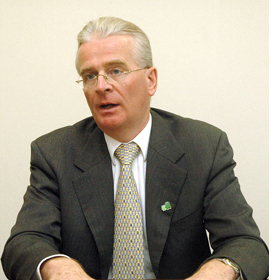 What we think is especially important about EXPO 2005 Aichi, Japan, is that it raises the issue of living in harmony with the environment as the biggest challenge for humankind. I think in approaching it this way, Japan has shown a great deal of wisdom and foresight, and what Japan is doing is setting the scene for Expos of the future. I think it is wonderful that participating countries are trying to transcend their individual national interests.
What we think is especially important about EXPO 2005 Aichi, Japan, is that it raises the issue of living in harmony with the environment as the biggest challenge for humankind. I think in approaching it this way, Japan has shown a great deal of wisdom and foresight, and what Japan is doing is setting the scene for Expos of the future. I think it is wonderful that participating countries are trying to transcend their individual national interests.More than 120 countries and international organizations are participating in EXPO 2005, and people will be visiting one pavilion after another. So, there will just be a mosaic in their minds of what they have seen at the Expo. That is why, at the New Zealand Pavilion, we want to be modest and aim to leave a deep impression of just one or two things. We are encapsulating the essence of New Zealand and its nature in our pavilion. And we also show how we, as New Zealanders, live with nature, how we develop as a high-tech society, but in a way that is in harmony with the environment. We want people to come away thinking, “Gosh, New Zealand is beautiful, but it's also smart and innovative!” There are several key symbols at the New Zealand pavilion. We have the sky with a cloud; water, as part of our extensive rainforest; and a large boulder called a “Pounamu,” which is the central feature of the pavilion. “Pounamu” is a Maori word meaning “green stone.” This boulder of jade, which weighs about 1.8 tons, was discovered about 14 months ago and is very rare. We were able to exhibit it here though a special gesture of the Maori people. It represents the heart of New Zealand -- Mother Earth. Around the wall of the pavilion interior, we have a giant screen that will feature a film clip of New Zealand as seen through the eyes of a bird flying over the countryside. This is a combination of both real film and computer animation. Visitors can access the mobile phone portal for our pavilion (http://nzmobile.jp) with their cell phones and view all sorts of information about New Zealand, including the “Nature’s Wisdom” theme, or use the QR Code (Quick Response Code) at the pavilion to access the site. There will be the highest level of participation by VIPs from New Zealand. We, as a nation, are taking EXPO 2005 very seriously. |
|
![]()
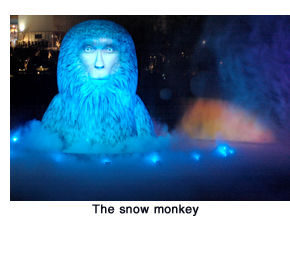 There will be various events held at EXPO 2005 Aichi, Japan for the enjoyment of visitors. One of them is “In the Evening at Koi-Pond.” It is a show held every night at Koi-Pond, located in the Nagakute Area Central Zone, for about a half hour beginning at 8:00pm.
There will be various events held at EXPO 2005 Aichi, Japan for the enjoyment of visitors. One of them is “In the Evening at Koi-Pond.” It is a show held every night at Koi-Pond, located in the Nagakute Area Central Zone, for about a half hour beginning at 8:00pm.This outdoor evening event, the largest in scale in Expo history, was produced by Robert Wilson, an American director of contemporary theater and a world-renowned master of experimental theater. Each evening, EXPO 2005 visitors gather at bleachers set at one side of the pond. The show, with a holding pond and a backdrop of forest - both symbolic of Japan - as its stage, begins. Against a background of a dark forest, water sprays up from the pond and creates a screen upon which a cute anime monkey appears. The monkey is the conductor of the story that is about to unfold. The lights of images projected on the screen are reflected on the surface of the water, enveloping the whole pond in a multitude of colors. |
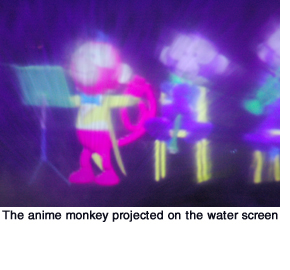 Something slowly appears from inside the pond and shows its giant form. It is a snow monkey, a messenger from the forest. It lives in coexistence with nature and is the symbolic character that transmits nature’s wisdom to humans. The snow monkey is the main character of this show.
Something slowly appears from inside the pond and shows its giant form. It is a snow monkey, a messenger from the forest. It lives in coexistence with nature and is the symbolic character that transmits nature’s wisdom to humans. The snow monkey is the main character of this show.On the screen, visitors see a story in four parts: “Earth,” “Life,” “Civilization” and “Future.” The audience sees the universe, including the Earth and other planets, images of the civilizations established by humankind, and other scenes of dream-like beauty. They experience a journey beyond time that begins with the past, and moves on to the present and future. It is a show that can be enjoyed by all ages. Robert Wilson, producer, said: “Producing this show was an exciting challenge. It was the first time for me to project footage onto a screen made of water. There were many things that happened along the way. The water froze when it was too cold, or the wind was sometimes too strong. I think the biggest challenge was producing the show without destroying the natural environment. This is an event that contemplates and expresses “Nature’s Wisdom.” It is also a show filled with poetic sentiment that can be enjoyed by both children and adults. I look forward to everyone enjoying this show.” Sit back and enjoy this fantastical event after spending a day visiting the pavilions. |
| EXPO 2005 AICHI, JAPAN Newsletter | |
| To read past issues:Back Number | |
| Editor/Publisher: Japan Association for
the 2005 World Exposition Head Office: 1533-1 Ibaragabasama, Nagakute-cho Aichi 480-1101 Japan Nagoya Office: Nagoya Daiya II Bldg 4F, 3-15-1 Meieki Nakamura-ku, Nagoya, Aichi 450-0002 Japan Tokyo Office: Iino Bldg 8F, 2-1-1 Uchisaiwai-cho Chiyoda-ku, Tokyo 100-0011 Japan |
 |
© Japan Association for the 2005 World Exposition
